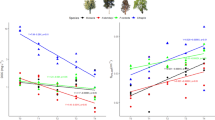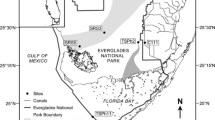Abstract
Goal, Scope and Background
One of the advantages of long-term mesocosm experiments as compared to short-term standard toxicity tests in the laboratory is the potential for detecting secondary effects due to the interaction of species and recovery with biomass of macrophytes being an important endpoint. However, generating biomass data by harvesting is often laborious, time-consuming, costly and restricted to the end of the experiment. Moreover, valuable information may get lost, in particular in single application studies, since maximal primary effects and secondary effects or recovery occur per se at different times. Potamogeton natans was used as an example in order to test whether number and area of floating leaves can be reliably measured and be used as intermediate and final endpoints in mesocosm effect studies.
Methods
Digital photos, which were taken of the water surface in the course of an indoor pond mesocosm study on herbicide effects, were subjected to image analysis. The results were compared to wet weight and ash-free dry weight of Potamogeton at the end of the herbicide study.
Results and Discussion
Both number and area of floating leaves indicated the same herbicide effects as wet weight and ash-free dry weight of Potamogeton. Error introduced by the different work steps is small and can be further minimised by a number of method improvements.
Recommendations and Perspectives
In indoor mesocosm studies, errors due to the perspective adjustment may be circumvented by taking the photos perpendicular to the water surface. Correction for lens aberration, identical light conditions and the use of fluorescence images are considered promising. Field applications are proposed.
Similar content being viewed by others
References
Caquet T, Lagadic L, Sheffield SR (2000): Mesocosms in ecotoxicology (1): Outdoor aquatic systems. Rev Environ Contam Toxicol 165, 1–38
Davies J, Honegger JL, Tencalla FG, Meregalli G, Brain P, Newman JR, Pitchford HF (2003): Herbicide risk assessment for non-target aquatic plants: Sulfosulfuron — A case study. Pest Man Sci 59, 231–237
DIN/EN/ISO (2006): 20079 Water quality — Determination of the toxic effect of water constituents and waste water on duckweed (lemna minor) — Duckweed growth inhibition test
Hanson ML, Sanderson H, Solomon KR (2003): Variation, replication, and power analysis of Myriophyllum spp. microcosm toxicity data. Environ Toxicol Chem 22, 1318–1329
Krausch HD (1996): Farbatlas Wasser-und Uferpflanzen. Ulmer, Stuttgart, Germany
Lozán JJ, Kausch H (1998): Angewandte Statistik für Naturwissenschaftler. Parey, Berlin
Lyrtle JS, Lyrtle TF (2001): Use of plants for toxicity assessment of estuarine ecosystems. Environ Toxicol Chem 20, 68–83
Mohr S, Feibicke M, Ottenströer T, Meinecke S, Berghahn R, Schmidt R (2005): Enhanced experimental flexibility and control in ecotoxicological mesocosm experiments: A new outdoor and indoor pond and stream system. Environ Sci Pollut Res 12(1) 5–7
OECD (2002): The work on test guidelines for aquatic plants (algae and Lemna) testing. ENV/JM/TG (2002) 12 OECD
OECD (2004): Guidance document on simulated freshwater lentic field tests (outdoor microcosms and mesocosms)
Wetzel RG (2001): Limnology. Academic Press, San Diego, USA
Author information
Authors and Affiliations
Corresponding author
Rights and permissions
About this article
Cite this article
Berghahn, R., Mohr, S., Feibicke, M. et al. Endpoint ‘floating leaves’ of Potamogeton natans: A new method to evaluate the development of macrophytes in pond mesocosms. Env Sci Poll Res Int 14, 190–193 (2007). https://doi.org/10.1065/espr2006.07.324
Received:
Accepted:
Published:
Issue Date:
DOI: https://doi.org/10.1065/espr2006.07.324




